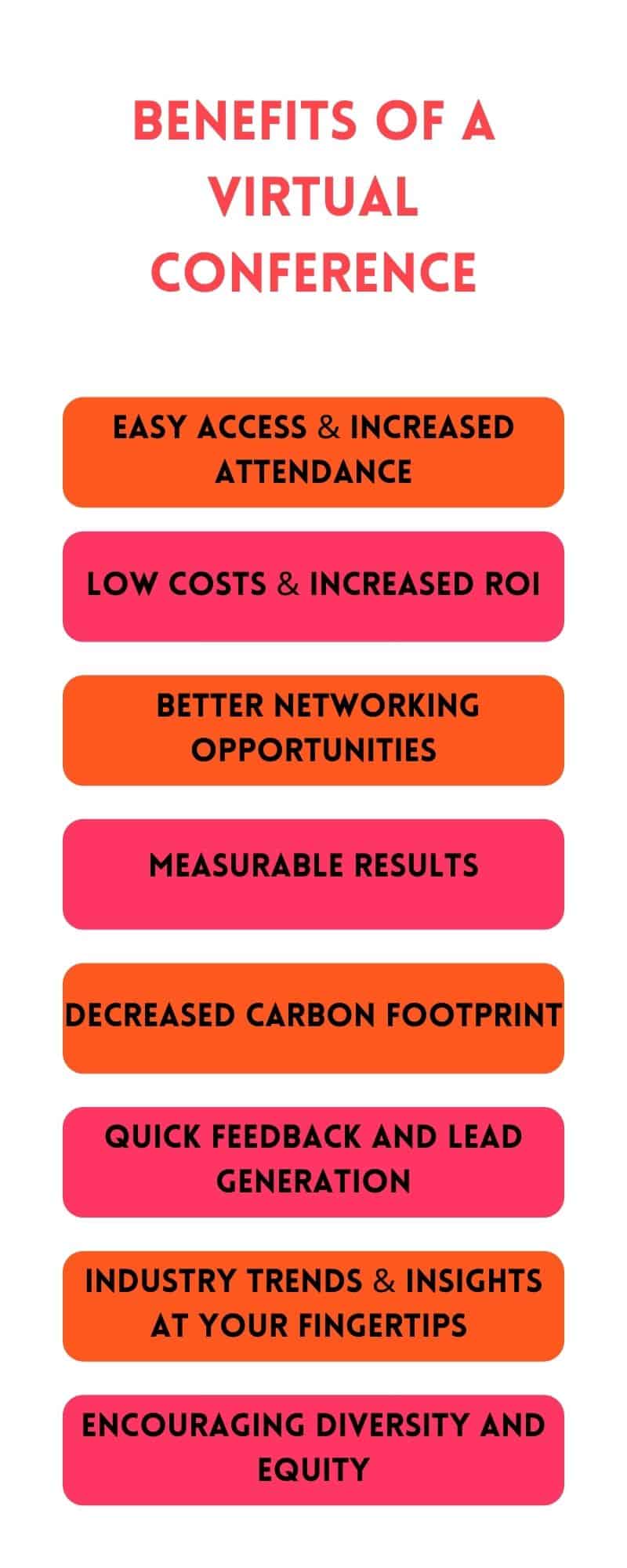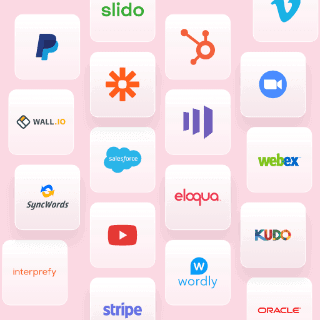Coronavirus gave everyone a run for their money. The events industry experienced a sudden shift. Yet companies and event organizers rose to the occasion and adapted to these changes. In the events industry, virtual conferences jumped in to save the day!
In a post pandemic world trends are changing in this industry and hybrid and virtual realities are the new norm. Completely changing the game for physical events. If you are an event company, or an organization making the move to a virtual conference platform, this guide is for you.
What is a Virtual Conference?
A conference is generally a gathering of like minded individuals. They discuss a theme or matter of common concern or interest. It brings together a large group of people who share common niche interests or expertise. To discuss, network, learn, and plan next steps.
A virtual conference is the same thing. Only it is an interactive, online event that takes place online. It can consist of keynote sessions, breakout sessions, and much more. With the purpose to interact and engage with audiences online.
The Benefits of a Virtual Conference
As we move into a hybrid reality, the lack of physicality does not necessarily have to rip the benefits of hosting a conference.
Learn how a virtual conference surpasses the value yielded from its physical counterparts.

1) Easy access and increased attendance
2) More value at reduced cost
3) Networking done right

4) Measurable results
5) Decreased carbon footprint
6) Quick feedback and lead generation
7) Industry trends & insights at your fingertips
8) Encouraging diversity and equity
Features to Look for in a Virtual Conference
1) Personalized tools

2) Easy to use
Platforms like vFairs that are intuitive and easy to use are important. If you want to save time, make sure the site you’re using automations. This comes in handy when you want to organize virtual events in a short span of time. You can ask virtual event platforms the following questions to inquire about automation:
- Can I get a tour of your backend?
- Will I need training to make use of your backend?
- How long will that take?
- How long does it take for your platform to reflect the changes on the frontend?
- Can the exhibitors/organizers make changes on the backend or do they have to involve your team for everything?
3) Live broadcasting and recording
It can’t be a virtual conference if it doesn’t let the organizers and participants interact live. Polls, Q&As, live chats, and trade shows are options your digital platform should provide along with surveys. You may also look for sites that support a multitude of slideshows and presentations from different speakers.
If you want to save time, pre-recorded content is a great option. Also, on specific webinars, recorded lectures are accessible at all times through registration.
4) Event marketing
A crucial part of virtual conferences is social promotion. You may want your lecture or online auction to reach as many people as possible. Plan the meeting with the help of your team and use Search Engine Optimization (SEO) tools such as tags, titles, and keywords.
You can use Facebook, Twitter, Instagram to promote your workshop or lecture. Attendees can share quotes, screenshots, or can even react to your online performance. For this purpose, try to find a platform that collaborates with social media outlets or supports the promotion of your event on social media.
5) Sponsorship
6) Troubleshooting and customer support

7) Reports and insights
8) Feedback and growth
To understand the user experience, you can set up surveys for your audience. That way, you can understand what your viewers want to see more or what they didn’t like. For example, you can schedule your meeting based on a poll about the date or specific topic. You can survey your sponsors too.
Questions to Ask Your Virtual Conference Provider
1) Will I get a detailed demo of my virtual conference?
2) Are there any past events that can be shared?
3) How long does it take to set up?
Do enquire about the average time it takes for the provider to set it up. From start to finish. This will assist you in chalking out your entire pre-event marketing strategy. And will also give your team enough time to prepare for the live event. The ideal time for a high caliber provider should not cross 4-6 weeks to set up your virtual conference.
4) Where will the virtual conference be hosted and how secure will it be?
Make it a point to ask your virtual events provider about the hosting company that they partner with. And the specific security features that they have in place (like RAID, Uptime, Secure Datacenter). This is necessary as your conference should be secure from data fraud, viruses, and crashing servers when the event sees bulk registration.
5) Is the platform compatible across devices and operating systems?
While your visitors will be accessing your conference using smart devices, you need to make sure you provide them with a seamless experience on their smartphones, laptops as well as tablets. In addition, ensure that your vendor provides event hosting compatible with Android and iOS platforms. After all, you do not want to lose visitor acquisition or engagement due to poor technology compatibility.
6) Who owns all the data?
The data stored on your virtual event platform will oftentimes be highly confidential. Make sure your contract clearly states the provider’s right to store and process the data whilst relinquishing all data ownership to your organization.
7) What kind of support do you offer?
You want to be sure that the solutions provider is not choosing a one-size-fits-all solution for you. It should deliver customized instructions across all phases from booth design, event layout, and marketing. A team dedicated to providing you end to end support will prove most important. Ensuring that you won’t have to manage the event in its entirety.
vFairs assigns dedicated project managers to all its clients as a key point of expertise so that all concerns are promptly addressed and objectives met.
8) What are the different engagement & interactive features that are available?
You want to be able to attract, excite, and engage the visitors to leave the intended impact. This plays a huge role towards the success of your virtual conference.
Depending on the kind of virtual conference discuss with your team, if you want textual, voice or video chat-based functionality. Perhaps you want individuals to partake in webinars through a virtual whiteboard. Maybe you need multilingual features to reach an audience that does not speak the native language of your event.
Be specific with how you choose to engage with your visitors so that your virtual conference is one to be remembered.
9) What sort of accessibility options are available for differently-abled visitors?
One of the key points of a virtual conference in comparison to its physical counterparts is that it is accessible and inclusive. It invites quality individuals based on their skills and relevance instead of restricting them based on their disabilities. Look for features such as:
- color contrast for visually impaired individuals
- text size adjustment
- page narration
- webinars with subtitles
- clear and straightforward layout for easy navigation
If you wish to reach the globe and offer value to people from the comfort of their homes, it is imperative to offer a diverse and equitable platform.
Look for accessibility features in your next virtual events provider or talk to our representative to understand more on delivering all that a virtual event truly needs to comprise of.
Click here to read more about accessible & inclusive virtual events.
10) What type of reports will be generated?
The vendor of your choice should also provide reports that measure the impact of your initiative on your audience. These reports should help determine your KPIs in advance, for example, unique visitors or visits per booth.
Measuring success is pivotal to determining the ROI. Discuss with the vendors how they can help you monitor visitors, downloads, video plays, chats, conversions etc. before you choose to go ahead with them.

Defining your Virtual Conference Content Strategy
To set up a successful event, whether virtual or in-person, you need to put a strong content strategy in place. This includes the design, creation, and management of engaging content across your landing page, social media platforms, e-newsletters and everywhere else your target audience resides.
A strong content strategy is vital to inspiring, informing, and raising awareness about your event and your brand.
1) Determine your event type and your client profile
Who is your target audience? What is it looking for? What are your company objectives, and do you require a meeting, conference, or a summit to fulfill those?
Streamline your goals and user needs to bring them in line with your content efforts. Simply put – everything you do related to content should resonate with those predetermined conditions.
2) Plan the visual experience
Landing page
For the event vendor to set up the virtual conference homepage, start searching for design inspiration (your vendor should be able to share ideas and templates). Brainstorm content for:
- Title of the event – Remember to keep it short and sweet (and in-sync with event domain address)
- Logistics – Event date, timings and time zone
- Content for homepage such as agenda, logos, FAQs, introductory videos – The landing page will be a summary of who is participating, what to expect, why visitors should participate and quick overviews of all things important for the audience to know. Ensure a power packed introduction that will motivate your audience to register without delay
- Cover image and high-resolution logo for the event – Make your brand shine bright with a high-resolution cover image and logo, it’s like a flag your mark your territory with – quality is essential
- Attendee Registration – Determine information fields you would like to capture on the registration form to setup form
- Registration Communication – Prepare drafts for attendee correspondence (once an individual registers for your event, they will receive an automatic registration confirmation email and shown a thank you note).
Lobby Design
The hub of all event navigation, the “Lobby” is the area your visitors will be routed to once registered and logged in.
- Select display – Choose if you’d prefer an animated or static lobby and review available designs/samples from past events. (Our recommendation: An animated lobby delivers a stronger “wow” factor to greet guests).
- Decide lobby banners and logos – for e.g. if your exhibitors have paid extra to secure best logo visibility, their brand promotion should be prioritized over others.
- Discuss customizations – Explore other possible customizations with your virtual career fair vendor such wall posters and visitor avatars that can be displayed.
- Exhibitor Hall Design – Similar to the lobby, the “Exhibitor Hall” in a virtual conference is totally configurable to cater to your content preferences including: a) hall background image b) booth floor layout c) static staff avatars
- Auditorium Design – Gear up to explore auditorium design alternatives so you can add your logo/logos or customize virtual posters as needed.
3) Piece Together the Content for Booths
Now that you’re done setting up a visually impressive, eye-opening, jaw-dropping experience for your attendees, it’s time to add some value for their consumption.
The virtual platform accommodates formats including documents, videos, presentations, picture galleries, live or pre-recorded webinars and much more. This gives exhibitors a large range of options to deliver and cater to their audiences.
4) Plan out an agenda
Creating a webinar schedule that accommodates the schedules of your audience as well as speakers is key to your conference’s success.
Your landing page should ideally consist of a clear schedule of your webinars, the topics of discussion, and the speakers appearing – for those who wish to hop in during the hours of their interest.
Pro tip: You can even get attendees to customize their own agendas on the live day(s) so they do not miss out on key sessions.
5) Promote your event
Use social media platforms, your company website, independent landing pages (such as microsites), and all other mediums where your target audience is present. Attract their attention and provide them with the information necessary for them to understand what your event is about, and eventually compel them to register for it. Make sure you compliment and link every piece of content with a direct call to action.
Want to learn how to promote your event? Check out our Playbook on How To Attract Attendees to Your Virtual Event.
7 Quick Steps to Host a Virtual Conference
Even though virtual conferences have been present for quite some time, the world has yet to master the tool. If done correctly, virtual conferences can be even more powerful than any traditional in-person conference.
Here are some step by step guidelines to ensure the best virtual conference.
Step 1: Define the goal of your virtual conference
What do you want to achieve with this conference? What business objectives will your conference help you attain? Who is your target audience? Which speakers will benefit the topic of your conference? What metrics will you be measuring to measure the success of your event? Is this conference largely for idea sharing? Networking?
All of this helps you and your team construct a clear picture of your event goals, and directs them to take the relevant measures to get to the finish line. Once your goals are better defined you will be able to better utilize various virtual platform features.
Step 2: Choose a reliable virtual conference platform
The choice of a platform is greatly dependent on the sort of tools and amenities you require for the success of your event. Essentially, the goal of every virtual conference is to provide the ability to interact and network with people, mostly where the audience draws value from.
Make sure your virtual conference provider offers multiple options as engagement tools, such as live webinars and real-time chat in real time. Not just that, you need to ensure that the technical equipment you’ve acquired will support seamless operations, and if need be, a pro-active technical support team is always on standby during the event.
Step 3: Identify the best tools for engagement
Once you have defined your objectives and goals for the event you will be able to ascertain what kind of features to use. For instance, if this conference is one where ideas are being shared, it would benefit from a virtual poster hall. Here various researchers can share their findings on particular topics.
Does your conference offer some training? You can accredit certifications as an added plus for attendees. You can even create a virtual photo booth for your attendees to take pictures that can be shared on the photo wall.
Can you engage attendees over social media and promote your event through hashtags? For that reason you can use the social media wall. At vFairs, your dedicated project manager at vFairs will assist you to identify all the features that will support your event goal.
Step 4: Invite relevant sponsor and exhibitors
For your exhibit hall, you will need exhibitors who attendees can learn about or engage with. Your sponsors will also generate revenue for yourself, so targeting those that will definitely sign on is important.
With an intuitive backend portal, they will be easily able to upload their material with little hassle to you and your team.
Step 5: Find speakers
The real catch for your audience is the speakers. Make sure you arrange speakers that your audience can relate with. Make sure your speakers are engaging and relevant to the topic. Make sure you have a decent moderator as well. Encourage them to make the webinars interactive through polls and Q&As etc.

Step 6: Promote your virtual conference
In order to achieve your attendance goals, you need to drive more registrations. At this point, your promotional efforts will play a key role in making or breaking your event. Some of the obvious channels to promote your event before its occurrence are:
- Social media – Once you have conducted research on your target audience you wll know which platform will work best for them. Facebook, Twitter, LinkedIn, Reddit, or any other platform your target resides on
- Email marketing – Make use of your existing mailing lists and new registrations from your landing page. Maybe you can promote registration discounts for those who can share emails of other individuals who can be interested in the event.
- Speakers’ social media – Ask you panelists to promote on on their networks
- Company employees – Ask colleagues to share within their networks as well
- Other websites – Paid promotions on other websites and pages. A banner, pop-up, or snack bar about the event
Step 7: Do a run-through
Before the day of the event, and once you have it all set up, do a dry run of the entire event with your virtual conference provider to ensure seamless operations and cater to any last moment glitches in the technology.
What Should You Be Measuring During and After a Virtual Conference
Virtual conferences are an effective way to network and communicate with groups and individuals belonging to a certain niche. They contribute to lead generation and business growth at the same time, just as any other physical conference.
What’s different is that you can now obtain definite results, set measurable KPIs and justify your ROI, previously unlikely to happen at an in-person conference. Therefore, we’ve compiled a set of key virtual conference metrics that can help you determine your online event’s success:
- Total registrations – while attendance is important, registrations can be just as useful. You can use the contact information that registrants submit in order to set up a database for marketing your business in the future.
- Number of attendees – Once you have the total number of registrants, you would like to know how many of them attended the event. The conversion rate will help you determine the effectiveness of your marketing efforts.
- Document downloads – At a conference, people are looking for information. The number of resources they consume will help you understand whether what you offered to them matches their needs, and hence, the value that they’re getting out of your virtual event. This information, as opposed to an in-person conference, assists in measuring your audience’s engagement.
- Video views – streamable videos attract great traction by audiences, total video views per booth help in determining the exact impact of the visuals.
- Chat usage – What makes any event a great success, especially conferences, is the engagement rate. With booths equipped with audio, video and text-based chat capabilities, interactions help understand how hooked the audience is.
- Total webinar attendees – An auditorium buzzing with activity is every host’s dream come true! Tracking participation can help monitor success, and enable comparison with preset event goals
- Attendees per webinar – Measuring participation per webinar helps zoom-in to audience’s needs and interests to better prepare for future conferences and summits, topics of discussion and live Q&A sessions
Your Virtual Conference: Key Takeaways
Welcoming brand new approaches and out-of-the-box ideas, these guys have turned their energies into innovating through virtual events, turning calamities into opportunities.
What’s best during these times is to keep moving forward, and picking up the right tools to face the fire.
About vFairs
At vfairs.com, we strive to build a top-class online event platform that will help event organizers make memorable connections with their target audience. We’re obsessed with taking out the hassle normally associated with physical events, leaving organizers and exhibitors to focus on what’s most important – engagement with the audience.
